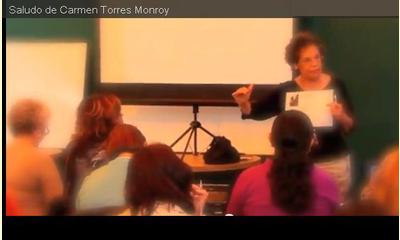|
|
International Seminar for a Culture of Peace: How to Stop Violence against Women [Mexico]
un articulo por Benemerita Universidad Autónoma de Puebla, Mexico
"There can be no peace in the world without peace between woman and man in the home" - with this slogan since 1919 the International Federation of University Women (IFUW), began the struggle for human rights and education of women, said Patricia Galeana Herrera, President of the organization.

Carmen Torres Monrroy (photo from her blog page)
click on photo to enlarge
Inaugurating the International Seminar for a Culture of Peace: How to Stop Violence Against Women, organized by the IFUW and the Faculty of Arts at the Benemerita Universidad Autónoma de Puebla (BUAP), the historian also recalled that this program of action has enabled the Federation to engage members in seventy-five nations today.
In affirming that education is both the beginning and the basis for effective change, she said the action program of the IFUW covers education for three purposes: freedom from violence, to financial independence and the forging of a sustainable future.
"Our federation associated itself very early with the work of women who opened the struggle for the rights of women, and we continue to fight for the defense of women's human rights as a fundamental element for the integral development of peoples," affirmed Galeana Herrera.
Also at the seminar, Fernando Santiesteban Llaguno, BUAP Vice Rectorfor Extension and Diffusion of Culture, stressed the importance of addressing issues such as violence, because, although in some places it has decreased in others it has worsened. For this reason, he emphasized that the effort made by the International Federation of University Women deserve to be rewarded.
During the inauguration of the seminar, Carmen Torres Monroy, academic from the National Autonomous University of Mexico (UNAM), in presenting her paper "The origins of violence and its effect on women's lives," said that it originated from the biblical myth of the fall, where he Adam is given power over the world. She stressed that this myth, belonging to Western culture, gives rise to the different existential situations of men and women: "it demonstrates that if we cannot achieve equality, it is because we have emphasized and valourized a unique space where we can work".
Monroy Torres explained that "from the beginning, patriarchal power and rule, violence and guilt all arose at the same time. Power is the first form that appears along with the principle of only one truth, and from that day on the various ideologies all claim that their truth comes from divine revelation. "
Hence also arose misogyny, the ancient prejudice by which the political, religious and social domination of men has reproduced contempt of women, she said.
Finally the researcher noted that these different ideologies and myths have engaged in the repetition of traditions, but ethics can help to transform and modify them.
(Click here for a Spanish version of this article)
|








|
DISCUSSION
Pregunta(s) relacionada(s) al artículo :
Protecting women and girls against violence, Is progress being made?
* * * * *
Comentario más reciente:
:
The 47 CPNN articles devoted to this theme suggest that indeed progress is being made.

|
|









